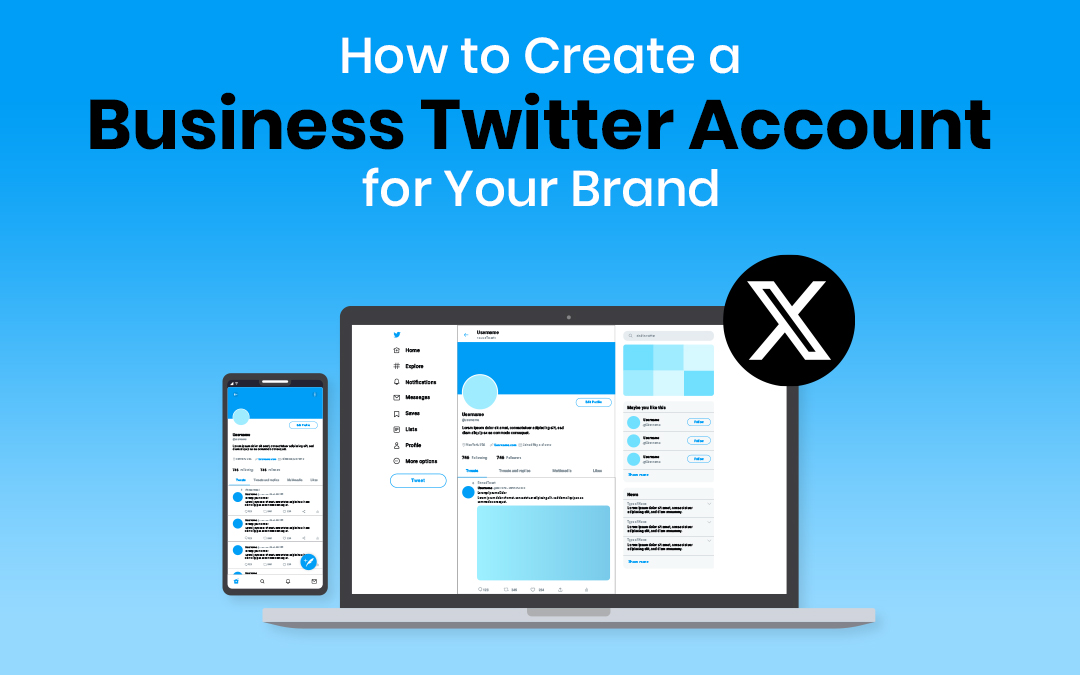How to create a Twitter account: Twitter has become an essential platform for businesses to engage with customers, build their brand, and increase sales. With over 200 million daily users scanning their feeds for new information, setting up an effective Twitter presence offers a vast opportunity to reach new potential customers. However, with the platform continuously evolving, businesses need to understand the best practices for optimized engagement and maximum results. In this article, we will explore the key factors to consider when setting up your business Twitter account in 2025.
How To Set Up Twitter For Business In 4 Steps
Setting up an engaging Twitter presence for your business doesn’t need to be a daunting task. With some thoughtful planning and proper setup, you can be well on your way to connecting with brand fans and attracting new customers.
Here are the 4 key steps in more detail:
Step 1: Create A Twitter Account

First, visit twitter.com and click ‘Sign up’ to create your business account. Choose a memorable username related to your brand that is still available. For example, if your business name is “The Bakery Cafe”, consider using @TheBakeryCafe rather than your name. Next, add your business trading name and a short description highlighting what you do. A URL link to your company website is also important to include.
Now it’s time to decide on profile customizations. You’ll want a high-quality square image that represents your brand as well as the profile photo. Get creative with graphic design software and use illustrations or product shots rather than selfies. Similarly, choose an aesthetically pleasing wide-format header image that works across all devices.
Feel free to use brand imagery, photos from your catalog, or designed graphics here. Finally, write a compelling 160-character biography describing what makes your business unique in a fun, conversational tone to engage new followers. Be sure to include useful keywords, tags, and calls to action for potential customers.
Step 2: Optimize Your Profile

Now it’s time to fully complete your Twitter profile by adding important details. Profiles with more information come across as trustworthy and help followers learn about you. Be sure to include your business location, regular trading hours, and contact details like phone number and email for easy access. You can also create a website URL link using your domain to direct people back to your online store.
It’s also helpful to upload any team member photos and introduce the friendly faces behind the brand. With a team profile, customers get to know the individuals creating their experience. Define your company culture and story further through social media pages, blogs, or videos linked here.
Highlight relevant hashtags you regularly use for improved discoverability across the platform too. Make it obvious this is a business account by using formal profile names and images rather than personal details for a serious presence.
Step 3: Set Up Twitter Business Features

To access advanced account settings, it’s recommended to upgrade to a Twitter business profile. This provides key analytics, engagement metrics, and tools for successful campaigns. Click the ‘Professionals’ button within profile settings to sign up. The Partner Account Manager program connects you with direct Twitter support for assistance in optimizing your reach.
Deeply analyze your follower demographics for targeted campaigns with more advanced insights too. Another perk is enabling your business phone number with Click to Call functionality for quick contact from interested leads.
You can also schedule tweets and manage multiple team member access from the same upgraded dashboard. Remember, a large part of your tweet strategy includes responding quickly to mentions, messages, and comments. The business tools make community engagement more seamless versus personal profiles.
Also Read: How to delete Instagram account permanently? | Ultimate Guide
Step 4: Follow Relevant Accounts

Now it’s time to begin engaging with your industry on Twitter by following accounts you want to connect with. Searching industry terms, events, hashtags and locations related to your business niche will surface interesting profiles. Look for influencers in your field, similar companies, partners, media outlets and potential customers asking questions within conversations. Process of elimination helps evaluate authenticity – are accounts solely self-promotional or do they contribute to thoughtful discussions?
Gradually follow relevant profiles vs. mass following which can appear spammy. Interact with their tweets by liking, commenting or answering questions to network and provide value first. Over time, as rapport develops from consistent engagement, you can mention or tweet branded content to these connections specifically when it provides utility versus selling. Monitoring the quality of the accounts you follow will expose you to new experts and keep your timeline filled with enriching updates in your industry space.
Note: Implementing these 4 strategies step-by-step will lay the foundation for an optimized Twitter presence to help grow your business. Keep refining your approach and engaging conversations for ongoing success in your niche community.
Strategies To Use Twitter For Business
How To Set Up Twitter For Business In 5 Strategies
Harnessing Twitter’s powerful reach requires strategic planning and effort. Here are the key activities your business should focus on to build an engaged community and see real results.
Strategy 1: Create Shareable Content
Without compelling content, your Twitter presence is useless. Brainstorm topics relevant to your industry and customers’ interests well in advance. This may include tutorials, articles, infographics, branded hashtags for campaigns, or visually appealing photos/videos. Develop a content calendar that mixes formats for varied attention spans.
Keep tweets concise at 100 characters with CTAs to prompt desired actions. Quality, not quantity matters – hold off posting until fully developed material is ready. Test different styles like Q&As, quizzes, or contests to see what sparks engagement. Consistency in publishing is important but allows flexibility in adjusting the cadence based on how users interact.
Also Read: How to Make Reels on Instagram | A Step-by-Step Guide for Beginners
Strategy 2: Engage With Your Audience
While promoted tweets have value, your priority should be nurturing relationships. Comment on industry discussions, answer questions promptly, and like/retweet relevant third-party updates. Getting involved in conversations shows customers you care beyond sales. Dedicate time each day to checking direct messages and monitoring @mentions – address any issues raised right away.
Compliment or thank those interacting positively with your brand. Find opportunities to genuinely converse with individuals versus one-way self-promotion. Retweets are not the goal – focus on leaving thoughtful responses that add to discussions and strengthen your community presence over the long run.
Strategy 3: Utilize Twitter Ads
Although costly, targeted Twitter ads can significantly boost the reach of quality content and drive measurable actions like website visits or app downloads amongst ideal buyers. Become certified in Twitter’s PowerTrack tool to gain detailed analytics on ad performance. Choose compelling visuals and clearly define CTA that leads users off the platform.
Use audience insights like interests or behaviors to profile your perfect prospect when constructing ad campaigns. These “tailored audiences” perform much better than general hashtags or profiles alone. Leverage event hashtags to time promotions around major industry conferences or the campaign launch you’re covering as well. Check reporting regularly to drop underperforming ads and refine targeting criteria for top-converting campaigns.
Also Read: Top 25 Indian Beauty Influencers on Instagram | You Need to Follow
Strategy 4: Monitor With Analytics
All the engagement in the world means nothing without tracking key metrics over time. Upgrading to a business profile grants tools like built-in dashboards and spreadsheets exporting tweet stats. Track vanity numbers like follower count less rigorously here – instead focus on follower-to-following ratio, retweet, and like rates on different tweet types and hashtags mentioned.
Measure website clicks from tweets and see what content gets shared most. Monitor which hours see the highest engagement daily to refine schedules. Look at topic and account insights for who your strongest community members are. Look for trends across reporting to adjust strategies amplifying successes and removing wastage. These in-depth analytics are crucial feedback loops for continual growth.
Strategy 5: Build Relationships With Influencers
Within your space will be industry leaders with sizeable followings worthy of your investment. Monitor who they engage with and mention in conversations. Gradually follow and converse naturally by sharing their content to build awareness before direct outreach. Once rapport develops, explore opportunities for influencer marketing partnerships – whether sponsored posts, curated branded hashtags or campaign endorsements.
Clear guidelines like disclosure of relationships must be followed to steer clear of deception. Find “micro-influencers” or interactive accounts with highly engaged niche audiences as well to maximize trust and relevance over larger celebrities. Track any jump in metrics from influencer-driven campaigns and strengthen bonds with top-performing advocates over time.
Implementing each of these 5 points strategically ensures your Twitter efforts are optimized for long-lasting impact. Monitor performance and make gradual refinements to continually improve.
Conclusion
Setting up an optimized Twitter presence takes ongoing effort but allows businesses to stay top of mind with prospects, keep their audience interested, and gain helpful insights into customer needs. By customizing your profile to represent your brand, planning a mix of engaging content, employing relevant hashtags strategically, and making time for genuine user conversations, you lay the foundation for maximum audience growth and real business impact.
The platform is constantly changing but by following these guidelines, your business can set themselves up for ongoing Twitter success in 2024 while strengthening connections with customers every step of the way.






